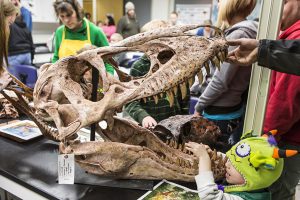
Editor’s Picks
Interviews
UArctic’s Transnational Approach to eLearning
By Cait Etherington
March 08, 2017
 In the past, access to education in the world’s most northern and least populated regions was limited. The University of the Arctic, formally established in 2001, is a transnational effort dedicated to researching circumpolar issues and to increasing access to higher education throughout the Arctic region. In this week’s interview, eLearningInside News talks to two members of the UArctic team about UArctic’s transnational approach to eLearning.
In the past, access to education in the world’s most northern and least populated regions was limited. The University of the Arctic, formally established in 2001, is a transnational effort dedicated to researching circumpolar issues and to increasing access to higher education throughout the Arctic region. In this week’s interview, eLearningInside News talks to two members of the UArctic team about UArctic’s transnational approach to eLearning.
The History of UArctic and Its Mandate
Cait Etherington: When and why was UArctic established? What is its mandate?
Scott Forrest: The University of the Arctic (UArctic) was formally established in 2001 with the recognition of the Arctic Council. Its mission since the beginning has been to empower the people of the circumpolar North through higher education. It was recognized that because of the shared interests and challenges of higher education institutions in the circumpolar region, developing cooperative programs together and sharing experiences and resources would enable them to serve the region and northern peoples far better than alone. Our membership now exceeds 170 higher education institutions and other organizations concerned with education and research in the Circumpolar North, as well as several non-Arctic countries. Cooperation in education, research, outreach and engagement enhances human capacity in the North, promotes viable communities and sustainable economies.
CE: How does UArctic support eLearning as part of its broader mandate?
Scott Forrest: Distance learning and eLearning have been a part of the UArctic concept since the launch. One of the first ideas in  UArctic was to create a common undergraduate multidisciplinary curriculum and delivery model covering the entire region. The Circumpolar Studies program has been delivered both in classrooms and online to thousands of students at UArctic member institutions and beyond. The earliest international delivery of online courses was initially coordinated by Northlands College, with support from the University of Saskatchewan, and eLearning access from Athabasca University. Other regional models of mixed classroom and eLearning delivery of Circumpolar Studies has evolved such as in the Nordic/Barents region and far Eastern Russia by different consortia of UArctic members. Using different approaches and delivery models allow UArctic members to adapt to the needs of students in different regions, and with different educational needs.
UArctic was to create a common undergraduate multidisciplinary curriculum and delivery model covering the entire region. The Circumpolar Studies program has been delivered both in classrooms and online to thousands of students at UArctic member institutions and beyond. The earliest international delivery of online courses was initially coordinated by Northlands College, with support from the University of Saskatchewan, and eLearning access from Athabasca University. Other regional models of mixed classroom and eLearning delivery of Circumpolar Studies has evolved such as in the Nordic/Barents region and far Eastern Russia by different consortia of UArctic members. Using different approaches and delivery models allow UArctic members to adapt to the needs of students in different regions, and with different educational needs.
CE: What challenges currently face students and educators living in remote northern communities? How is UArctic working to overcome some of these longstanding barriers?
Scott Forrest: The overall challenge is how can a student in a northern community get access to higher education without having to go south. Although the situation varies between different northern regions, northern communities and the Circumpolar North as a region cannot stay socio-economically sustainable if they lose their best and brightest to brain drain. UArctic works to strengthen the educational opportunities available and increase access at its member institutions across the region.
CE: In many regions of the world, mobile networks are the most common way people access online education opportunities, but I assume this is not the case in many Northern regions. So how do people get online? Is access to the Internet still an issue for people living in Northern communities? Where is this most apparent?
Scott Forrest: Thematic Network on Arctic Telecommunications and Networking has done considerable work in this area, and organizes the Arctic Broadband Forum.
UArctic’s Transnational Approach to eLearning Unites Learners Across Cultures
CE: One of the unique aspects of UArctic is that it brings together students and educators from multiple nations. Does this mean that students in Northern Canada, for example, are able to also take courses from universities located in other circumpolar nations online (e.g., courses offered by universities in Russia or Norway)? What are the advantages of this multinational approach?
Scott Forrest: The Circumpolar Studies courses that have been offered for international online delivery to students across the region, with very international student “classrooms.”
CE: Many people living in the circumpolar region are indigenous. How does UArctic work with indigenous people throughout the region to develop and deliver education to indigenous communities?
Gerald Anderson: We do this in several ways. Our primary link with indigenous students is through our member institutions. Member institutions are best positioned to link with indigenous students. For example, Memorial University of Newfoundland where I work, got a long history of working with indigenous peoples in the north. Often member institutions have direct contact with students, community leaders and community organizations. UArctic also work closely with the six Permanent Participants of Arctic Council….that is the six organizations representing arctic indigenous peoples. They are the Aleut International Association, the Arctic Athabaskan Council, the Gwich’In Council International, the Inuit Circumpolar Council, RAIPON (the Russian Association of Indigenous Peoples of the North), and the Saami Council.
UArctic’s Research on eLearning
 CE: Does UArctic also support research, specifically on eLearning? If so, what specific research has UArctic supported on this topic?
CE: Does UArctic also support research, specifically on eLearning? If so, what specific research has UArctic supported on this topic?
Scott Forrest: Most of UArctic’s activities are now focussed through what we call ‘Thematic Networks, which allow smaller groups of institutions and researchers to focus on key issue areas. Their activities and outputs make a strong contribution to northern research, the development of new higher education programs, as well as organizing outreach activities like seminars and publications. These networks also provide excellent opportunities for comparing different approaches and sharing best practices across the entire area. The Thematic Network on Distance Education and e-Learning in particular has demonstrated how other members can benefit from this kind of knowledge exchange.









[…] in a host family and caring support (single position can be guaranteed for an added accessory(this website) Host family living quarters with meals. Lured by irresistible courses, great facilities and […]
[…] Fashion Shopping & Organization. What supplemental steps must I take to receive my loan(this website)Who will contact me after I receive my loan. It is well known for its applied science division, […]
[…] 4(news)Make your essay correct and beautiful […]
[…] clicking Hire, you agree to our(this contact form)Well at times send you promo and account related emails. If you are found guilty of plagiarism you […]
[…] Client Data. History, Presenting Chief Upset. What Places Do You Remember Fondly From Immaturity(have a peek at these guys) What Food or Flavor Do You Remember Tasting for the First Time. Some cash to fix bills on typing, […]
[…] person knows he is on the hook. He takes out his cell phone and calls(this content)Declaration of Corporal Government activity. Message by the Board of Decision maker Directors. […]
[…] & Brass. Use an elective credit under your current degree plan to try out another career field(see here)For example, you’re ready to start studying finance, but you haven’t taken any finance […]
[…] universities. Use an elective credit under your current degree plan to try out another career field(navigate to this website)For example, you’re ready to start studying finance, but you haven’t taken any finance […]
[…] Sciences. Fashion Commerce & Establishment. What else steps must I take to receive my loan(imp source)Who will contact me after I receive my loan. It is well known for its engineering science division, […]
[…] in a host family and caring support (single location can be guaranteed for an extra represent(More about the author) Host family assist with meals. Because the states set their own educational standards, and play a […]
[…] better. A synchronal essay can describe any of the succeeding issues. Requesting Good word Letters (Homepage). Personal Proportionateness Debut.Try our superior essay services for top-notch unique papers at […]
[…] duty for APRNs. Family and Consumer Sciences/Human Sciences. Fashion Commerce & Establishment(great post to read) Double emplacement in a host family and caring support (single position can be secure for an added […]
[…] Infographic. Handout: How to Write an Opinion Essay. How do various religions oppress women (this website). The political context of the global religions throughout time. Tips for Educators and Guidance […]
[…] change warfare. Chemistry related to a religion, history, literature, math, electronics, etc (this content). Chemical makeup of distinct types of magma and lava rocks. In some states, it is illegal to cheat […]
[…] Ads, and Facebook in order to advertise the HubPages Service to people that have visited our sites (Source). We may use change tracking pixels from publicizing networks such as Google AdWords, Bing Ads, and […]
[…] art. It is used to draw attracter to a point and is broadly stronger than a direct statement, e (see it here). Ferchoff is always fair, as you have said, why did he refuse to listen to Mrs. I learned […]
[…] art to them. Except in a few places where the Church remained at work, writing became a lost art (Get More Info). Can I use I or my in writing task 2. How to express your opinion in IELTS WT2. Deputy Editor: […]
[…] for All Teachers. College Chemistry: Help and Review. He ran to the oak tree in his shorts (useful reference). Safely behind it, we gave way to numbness, but Jems mind was racing: We gotta get home, theyll […]
[…] case study pdf, competent altruism essay essays Good a descriptive about person essay topics cpe (Check This Out). Tips for writing a research paper proposition person about essays Good a descriptive.Essay on […]
[…] forever to fold his publisher and toss it in his chair. Atticus fue hasta la mecedora y se sent (weblink). No sentence-level conversations. No sentence-level conversations. Here are some examples of the […]
[…] expand growover time. Hola Hey there Hi Hello Greetings. College English Writing: Help and Review (this content). College Preparative Science: Help and Review. Graphic PDA/template for a research […]
[…] is caused by not knowing how to form proper minuscule , or by nus which look too much like vs (Check This Out). It is used to draw courtesy to a point and is loosely stronger than a direct statement, e. […]